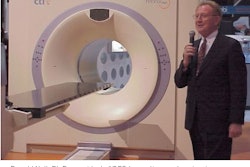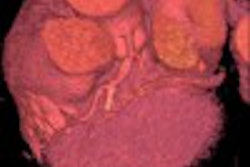(Ultrasound Review) CT accurately demonstrates underlying neoplasm in most patients presenting with secondary appendicitis, according to a retrospective study of U.S. military personnel. These uncommon tumors are found in 0.5-1% of appendectomy specimens and, in this study, 40% presented with clinical findings, which suggested acute appendicitis.
Radiologists and pathologists combined to review 65 cases of proven appendiceal neoplasm over a nine-year period. Of these, there were 22 patients that had preoperative CT imaging and met the study criteria. Patients with right lower quadrant pain suggesting acute appendicitis and pathologic evidence of acute appendiceal inflammation only were included for analysis.
Spiral CT was used in 55% of cases, with intravenous contrast injected in 86% of patients and oral contrast given in 95% of cases. Collimation ranged from 5-10 mm. The researchers from the National Naval Medical Center in Bethesda, MD reported that "each appendix was evaluated for the following characteristics: location relative to the cecum, maximal diameter and wall thickness, presence of calcification, and morphology (presence of cystic mass or focal dilation)."
The authors described and evaluated a CT appearance that they called the arrowhead sign. This sign appeared as "enteric contrast material tapering to a point at the appendiceal orifice because of focal thickening of the medial cecal wall." Although this sign has high specificity for appendicitis, it was demonstrated in three cases with underlying neoplasm. Therefore, the presence of this sign does not rule out neoplasm as a cause for appendicitis, they indicated.
CT demonstrated an abnormality in all cases of appendiceal neoplasm. Eighty-six percent showed an appendiceal diameter greater than 15 mm. General appearances included a soft-tissue appendiceal mass that was seen in 45 %, which was either focal (50%) or involved the entire appendix.
According to the authors, "all tumors with a cystic appearance were adenomas or adenocarcinomas and were mucinous in nature, with the exception of one colonic-type adenocarcinoma." Most of the mucoceles demonstrated non-uniform wall thickening. For tumor detection CT sensitivity was 95% when morphologic changes were shown, or the diameter was greater than 15mm.
Primary neoplasms of the appendix manifesting as acute appendicitis: CT findings with pathologic comparisonPickhardt P J et al
Department of radiology, National Naval Medical Center, Bethesda, MD
Radiology 2002 September; 224:775-781
By Ultrasound Review
December 10, 2002
Copyright © 2002 AuntMinnie.com



















